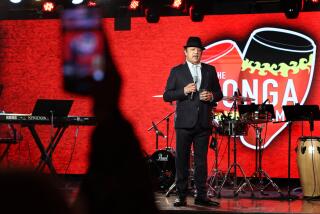No Bongos, But Lots of Rhythm From Costanzo
Jack Costanzo virtually introduced the bongo drums to American music in his performances with Nat “King” Cole, Peggy Lee and, especially, Stan Kenton (on such familiar items as “Peanut Vendor,” “Cuban Carnival” and “Bongo Riff”). He can probably also be blamed for providing the instrument that became a fixture in pine-paneled rumpus rooms of the ‘50s, and no beatnik poetry reading of the period was complete without bongo accompaniment. In addition, he lists stars such as Marlon Brando, Tony Curtis and Gary Cooper among his bongo students.
But when Costanzo came on stage at the Conga Room on Friday night, there were no bongos to be seen. Instead, he spent the entire set positioned behind a pair of conga drums. Nothing wrong with that musically, since Costanzo is a masterful percussionist with virtually any sort of hand drum. Still, it would have been nice to hear him take a turn on the smaller bongo drums, if only for the sake of nostalgia--especially since the packed-house crowd clearly included a contingent of enthusiastic listeners who remembered him from his earlier years.
To his credit, however, Costanzo has not remained in the past. The 10-piece band--with three vocalists, including the high-spirited Marilu--was a solid, hard-swinging unit. And the arrangements, many of which included Costanzo’s imaginative rhythmic ideas, used the five horns as a massed harmonic unit, the resulting sounds comparable to a full jazz band.
Combined with a surging rhythm section, the results were first-rate, a stunningly compatible blending of jazz horns with the infectious pulse of mambo, cha-cha and Latin funk. The combination was especially effective in an unusual rendering of Nat Adderley’s classic soul jazz tune “Work Song,” which began with a walking bass line, then quickly shifted into a jazz-tinged, foot-tapping, body-moving cha-cha.
Most of the other numbers featured singer Marilu, whose effervescent physicality and rich, dark-timbred voice was at times reminiscent of a youthful Celia Cruz, but more often was simply a convincing vehicle for her own unique style. Especially impressive on the rhythmic numbers--which were all enhanced by her nonstop dance movements--she was less so on the ballad “Te Quiero, Te Quiero,” a piece whose voltage was set far too low for this sort of dynamic evening.
But that was the only relatively passive moment in an entertaining evening of Latin jazz driven by the sheer rhythmic excitement of Costanzo’s drumming. “Mr. Bongo,” as he once was called, still knows how to get the fires burning, no matter what he’s playing.
More to Read
The biggest entertainment stories
Get our big stories about Hollywood, film, television, music, arts, culture and more right in your inbox as soon as they publish.
You may occasionally receive promotional content from the Los Angeles Times.










